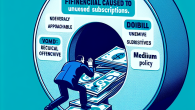
Need a Budget? Here’s How I Used YNAB Without Losing My Mind
Understanding the Basics of Budgeting: A Beginner’s Guide
Hey there, future finance whiz! I’m Tom Bradley, and if you’ve ever felt a little (or a lot) overwhelmed when someone says the word “budget,” you’re in the right place. I’ve been there. I used to think budgeting was some kind of punishment for spending money—but trust me, it’s quite the opposite. A good budget is your financial buddy, your money map, your ticket to not stressing when the rent is due.
So, whether you just got your first job, your college refund finally dropped, or you’re just trying to figure out where all your money keeps disappearing to (spoiler: probably coffee or delivery), let’s break budgeting down in a way that actually makes sense.
What Is a Budget, Really?
A budget is simply a plan for how you’re going to spend your money. It shows you how much money is coming in and where it’s going out. That’s it — no rocket science involved. Think of it like Netflix: you decide what to watch (or spend on), and you try not to binge too hard (overdraft alert!).
It’s not about never having fun or saying goodbye to Starbucks forever. It’s about knowing how much fun you can have without running out of money before your next paycheck hits.
Why Budgeting Matters (Even If You’re Just Starting Out)
Look, I know “budgeting” doesn’t exactly scream excitement, but here’s the deal: the earlier you start paying attention to your money, the easier — and better — everything else becomes. Here’s why it’s so important:
- Control: You’re steering the ship, my friend. No more “I don’t know where it all went” at the end of the month.
- Peace of mind: Knowing your bills are covered = sleeping better at night.
- Achieving goals: Dream vacation? Down payment? Emergency cushion? All start with a budget.
Step-by-Step: How to Create Your First Budget
1. Know Your Net Income
This is your take-home pay after taxes, not the big juicy number before Uncle Sam takes his cut. If you freelance or gig, estimate your average monthly earnings. That’s your starting point.
2. Track Your Spending
This might feel like a chore, but it’s essential. For one month, track every penny. Use an app, spreadsheet, or good old-fashioned notebook. Break spending into categories like:
- Rent or housing
- Utilities
- Groceries
- Transportation
- Entertainment
- Dining out
- Debt payments
Once you see where your money actually goes, the budget magic can begin.
3. Set Your Money Goals
What do you want your money to do for you? Goals keep budgeting from feeling pointless. They give your dollars a mission. Start with these:
- Short-term goals: Building an emergency fund, paying off a credit card, saving for a laptop.
- Long-term goals: Buying a house, retiring in style, becoming debt-free.
Put real numbers on your goals. “Save $500 in 3 months” is more helpful than “I should probably save more…”
4. Choose a Budgeting Method
There’s no one-size-fits-all approach, but here are a few beginner-friendly options:
- 50/30/20 Rule: Allocate 50% to needs, 30% to wants, and 20% to savings or debt payment. Simple and effective.
- Zero-Based Budget: Every dollar has a job. You plan for income minus expenses to equal zero — not zero dollars in the bank, but zero unassigned income.
- Envelope System: A cash-based method where you divide money into physical envelopes for each category. Works great if you tend to overspend digitally.
Pick one that feels right and tweak it as you go.
5. Adjust and Stick With It
Your first budget will probably not be perfect—like your first pancake, it might flop a little. That’s okay. Learning how to handle your money is a process. Review monthly and make adjustments. Maybe you realize you were way off on how much you spend on takeout. (Guilty.) Or maybe you undershot your grocery budget. Refine and keep at it.
6. Build an Emergency Fund
Before you dive into investing or big saving goals, take care of the basics: create a safety net of at least $500 to $1,000. Life happens. Cars break. Phones fall. That fund is the superhero cape for your budget.
Common Budgeting Mistakes (And How to Dodge ’Em)
- Leaving out expenses: Forgetting irregular costs like gifts, car maintenance, or annual subscriptions? That’ll mess things up fast.
- Setting unrealistic goals: “I’ll never eat out again!” Yeah… no. Allow some fun money — you’re human.
- Not tracking as you go: Budgeting isn’t “set it and forget it.” Check in weekly to see how you’re doing.
Free Tools That Make Budgeting Easier
You don’t have to go it alone. There are some fantastic tools (free ones!) to give your budget superpowers:
- Mint: Automatically tracks expenses and visualizes your budget.
- EveryDollar: Created by Dave Ramsey’s team. Great for zero-based budgets.
- Google Sheets: Old-school but highly customizable if you like spreadsheets. Many free templates online.
Final Thoughts from Tom
Listen, budgeting doesn’t mean you suddenly become a boring grown-up who never buys a latte again. It means you’re calling the shots with your money instead of wondering why there’s too much month at the end of your money.
If you build this habit early, it’ll serve you for life. Start simple. Stay consistent. You don’t need to be perfect — just better each month. Your future self will thank you, probably with a boatload of savings and a stress-free vacation.
Got questions or ready to dive deeper? Check out our About Us page to learn more about our mission to make money basics doable for everyone or reach out to us anytime.
Until next time — keep it smart, keep it simple. Go get that bread (and budget it, too).








Leave a Reply